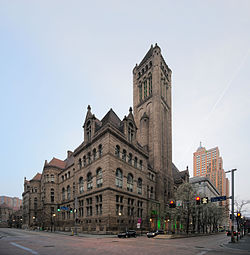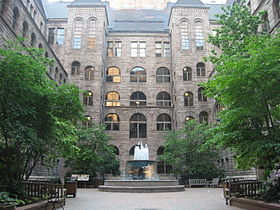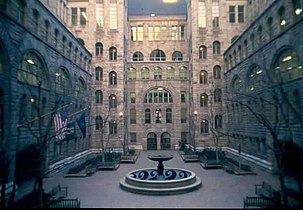
Union Station, also known as Pennsylvania Station and commonly called Penn Station, is a historic train station in Downtown Pittsburgh, Pennsylvania. It was one of several passenger rail stations that served Pittsburgh during the 20th century; others included the Pittsburgh & Lake Erie Railroad Station, the Baltimore and Ohio Station, and Wabash Pittsburgh Terminal, and it is the only surviving station in active use.

Minneapolis City Hall and Hennepin County Courthouse, designed by Long and Kees in 1888, is the main building used by the city government of Minneapolis, as well as by Hennepin County, in the U.S. state of Minnesota. The structure has served as mainly local government offices since it was built, and today the building is 60 percent occupied by the city and 40 percent occupied by the County. The building is jointly owned by the city and county and managed by the Municipal Building Commission. The Commission consists of the chair of the County Board, the mayor of the City of Minneapolis, a member of the County Board and a member of the Minneapolis City Council. The County Board chair serves as the president of the Commission and the mayor serves as the vice president. The building bears a striking resemblance to the city hall buildings in Cincinnati and Toronto. The City Hall and Courthouse was added to the National Register of Historic Places in 1974.
The Bridge of Sighs is a bridge in Venice. Bridge of Sighs may also refer to:

Frederick John Osterling was an American architect, practicing in Pittsburgh from 1888.

The Pittsburgh City-County Building is the seat of government for the City of Pittsburgh, and houses both city and Allegheny County offices. It is located in Downtown Pittsburgh at 414 Grant Street. Built from 1915 to 1917 it is the third seat of government of Pittsburgh. Today the building is occupied mostly by Pittsburgh offices with Allegheny County located in adjacent county facilities. It also contains a courtroom used for the Pittsburgh sessions of the Supreme Court of Pennsylvania.
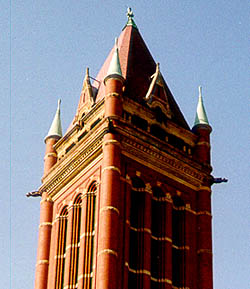
The Allegany County Courthouse is the Maryland Circuit court for Allegany County, Maryland, United States. It is located in Cumberland's Washington Street Historic District. Although many church spires dot the Cumberland landscape, it is the Allegany County Courthouse that dominates this city's skyline. The building is prominently sited along Washington Street, which rises sharply from Wills Creek running through the heart of Cumberland. Historically, courthouses in America have been one of the most architecturally impressive buildings within a community. In this way, the architecture of the building was able to convey the authority of a local government, as well as instill respect and recognition.

Chatham Village is a community within the larger Mount Washington neighborhood of the city of Pittsburgh, Pennsylvania, and an internationally acclaimed model of community design. It is roughly bounded by Virginia Avenue, Bigham Street, Woodruff Street, Saw Mill Run Boulevard, and Olympia Road, and was declared a National Historic Landmark in 2005 as a remarkably well-preserved example of Garden City Movement design.
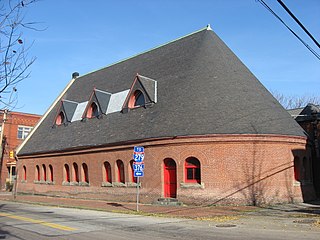
Emmanuel Episcopal Church is a church in the North Side neighborhood of Pittsburgh, Pennsylvania. Located at 957 West North Avenue at the corner of Allegheny Avenue, its 1886 building is known for its architectural features and was one of the last designs by Henry Hobson Richardson. It was declared a National Historic Landmark in 2000. An active parish of the Episcopal Diocese of Pittsburgh, it is known for offering a Sunday evening service of Jazz Vespers.

The following properties are listed on the National Register of Historic Places in Pittsburgh, Pennsylvania.

The Wayne County Courthouse is a historic courthouse located in Richmond, Wayne County, Indiana. It was built during the period 1890–93, and is in the Richardsonian Romanesque style. The building was designed by Cincinnati, Ohio, architect James W. McLaughlin and the construction was supervised by New Castle, Indiana, architect William S. Kaufman. The "U"-shaped building measures approximately 214 feet by 128 feet, and is constructed of brick faced with Indiana Limestone. It features a projecting entrance pavilion, high pitched hipped and gable roofs, large semicircular arches, and octagonal corner tower. Architectural historians Michael Tomlan and Mary Raddant-Tomlan have suggested that the Wayne County Courthouse was influenced both in terms of exterior design and elements of interior layout by Henry Hobson Richardson's Allegheny County Courthouse in Pittsburgh, Pennsylvania.

The Joseph F. Weis, Jr. U.S. Courthouse is a Beaux Arts-style building in Pittsburgh, Pennsylvania, US. It is a courthouse for the Western District of Pennsylvania, a United States district court. Until 2015, the building was known as the US Post Office and Courthouse-Pittsburgh.

Frederick C. Sauer was a German-American architect, particularly in the Pittsburgh, Pennsylvania, region of the late 19th and early 20th centuries.
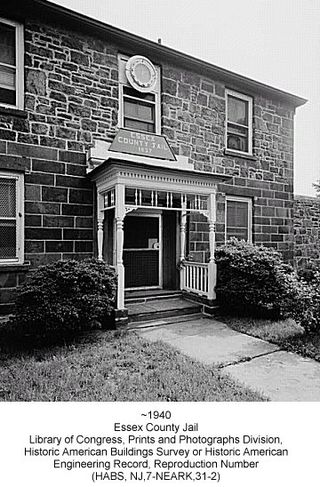
The old Essex County Jail is located in the University Heights section of Newark, Essex County, New Jersey, United States. The jail is Essex County's oldest public building and a national landmark of value for its architectural and social history. The complex consists of about 20 structures of various size, age, and function ranging in date from the 1830s to 1930s. Collectively, they represent the evolution of American prison history over 100 years. For the quality of its architecture, its social history, and its links to the 1967 Newark Riots, this jail was added to the National Register of Historic Places on September 3, 1991.

The Clarion County Courthouse and Jail is a historic courthouse and jail located in Clarion, Clarion County, Pennsylvania. The courthouse was built between 1883 and 1885, and is a 3 1/2-story, brick Victorian structure with Classical details measuring 78 feet, 8 inches, wide and 134 feet deep. It has a 213 foot tall, 25 feet square, clock tower. The jail was built between 1873 and 1875, and is a half brick / half sandstone building, located behind the courthouse.

The current Allegheny County Jail opened on April 29, 1995 at 950 Second Avenue, Pittsburgh, PA 15219. This facility replaced the old jail that is located on Ross Street and Fifth Avenue in downtown Pittsburgh, Pennsylvania.
Grant Street is the main government and business corridor in Pittsburgh, Pennsylvania. It is home to the global headquarters of U.S. Steel, Koppers Chemicals, and Oxford Development. It also is home to the seat of Allegheny County, City of Pittsburgh and the regional Federal Government offices. It is part of the Pittsburgh Central Downtown Historic District.

George Sherwood Richardson (1896–1988) was an American engineer known for his elegant bridges, innovative construction techniques and skillful planning of highways. Designer of many bridges in the Pittsburgh and Allegheny County areas in the 20th century, he has been called "the dean of Pittsburgh bridge engineers".

The Lavaca County Courthouse, in Hallettsville, Texas, is a courthouse which was built in 1897. It was listed on the National Register of Historic Places in 1971.

The Albright United Methodist Church is a disused church building at 486 S. Graham Street at the nexus of the Bloomfield, Shadyside, and Friendship neighborhoods of Pittsburgh, Pennsylvania, US. The church was designed by architect Chancey W. Hodgdon in an Eclectic, Richardson Romanesque style with prominent elements of Gothic Revival, and was built in 1905-1906.
